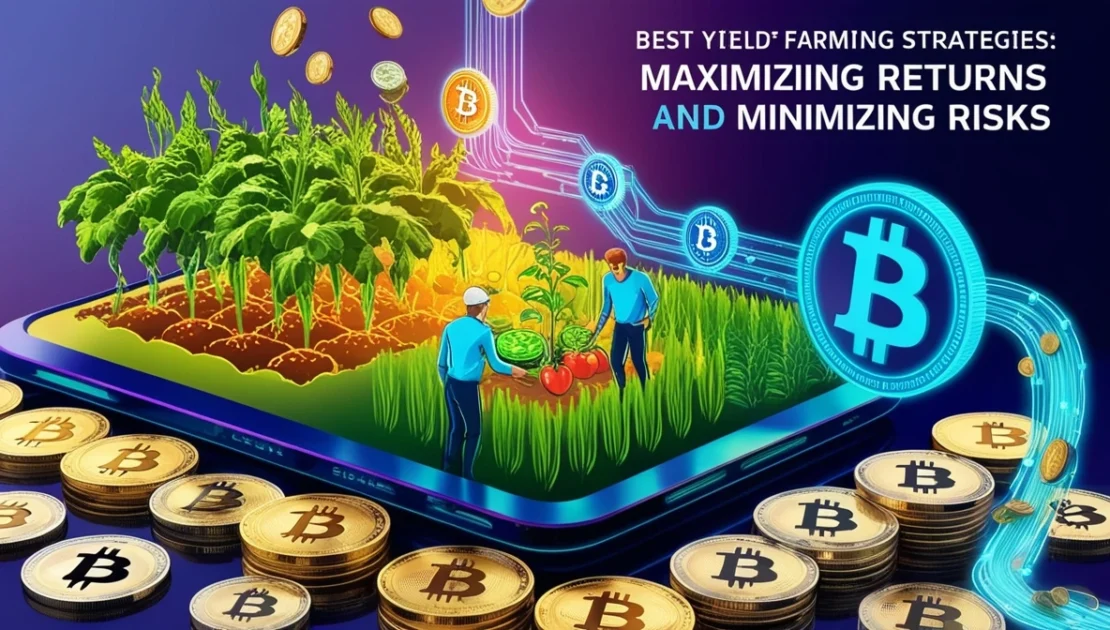Best DeFi Yield Farming Strategies: Maximizing Returns and Minimizing Risks
Yield farming is one of the most popular investment strategies within the decentralized finance (DeFi) ecosystem. It allows users to earn rewards by providing liquidity to various DeFi protocols. But how does it work, and how can investors maximize their returns while minimizing risks?
At its core, yield farming involves lending or staking cryptocurrencies in exchange for interest or rewards. This process is often compared to traditional farming, where users “plant” their digital assets and “harvest” returns. As DeFi platforms have evolved, they now offer a range of financial services without the need for intermediaries like banks or brokers.
This article dives deep into how yield farming works, key strategies to maximize returns, and essential concepts that investors need to understand to minimize risks.
What is Yield Farming?
Yield farming is a method used in DeFi to earn rewards by providing liquidity to a platform. Think of it like this: when you deposit your money into a bank, the bank lends it out and pays you interest. Yield farming follows a similar concept, but instead of lending to borrowers, you’re providing liquidity to DeFi platforms, which use it to facilitate trading or lending.
The rewards can vary depending on the platform, the type of asset staked, and the risk level. Some platforms offer native tokens as rewards, which can either be reinvested or sold on the open market.
The Mechanics of Yield Farming
To participate in yield farming, you must first deposit your assets into a liquidity pool. These pools are crucial for decentralized exchanges (DEXs) and lending platforms, as they enable the flow of assets and transactions.

In exchange for providing liquidity, users earn rewards in the form of transaction fees or native tokens. Here’s a breakdown of how it works:
- Select a DeFi platform that offers yield farming.
- Connect your crypto wallet to that platform.
- Choose a liquidity pool and deposit your assets.
- Earn rewards as other users trade or borrow assets from the pool.
- Monitor returns and adjust strategies based on market conditions.
Smart contracts, which are self-executing contracts with the terms of the agreement written directly into code, manage the entire yield farming process. These contracts ensure transparency, security, and automation.
Important Concepts: APY, APR, and Impermanent Loss
Understanding the financial metrics behind yield farming is essential.
- APY (Annual Percentage Yield): APY takes compounding into account and represents the real earning potential over a year. It’s often used as a more accurate measure than simple interest.
- APR (Annual Percentage Rate): APR, on the other hand, reflects the annualized interest rate without factoring in compounding.
- Impermanent Loss: This happens when the price of assets in a liquidity pool changes. For example, if you provide liquidity for Ethereum and USDC and Ethereum’s price rises sharply, you could experience impermanent loss because the pool’s balance adjusts to maintain a constant ratio between the two assets.
Top best Yield Farming Protocols in 2024
As the DeFi landscape grows, new protocols emerge, each offering unique advantages. Some top protocols include:
- Aave: A decentralized lending platform allowing users to earn interest and participate in yield farming.
- Curve Finance: Known for its stablecoin liquidity pools, Curve minimizes slippage, making it a top choice for stablecoin farmers.
- Yearn Finance: An aggregator platform that automates yield farming, optimizing returns for its users.
Strategy 1: Stablecoin Liquidity Provision
One of the safest strategies in yield farming is providing liquidity with stablecoins like USDC, DAI, or USDT. Since these coins are pegged to the value of fiat currencies, they experience minimal volatility, making them ideal for risk-averse investors.

Sub-strategy: Low-Risk Stablecoin Farming
- Risk Level: Low to Medium
- Potential Returns: 5-20% APY
- Best For: Conservative investors, beginners
Strategy 2: Blue-Chip Token Farming
Blue-chip tokens like Bitcoin, Ethereum, and Binance Coin are well-established assets. Farming with these tokens involves less risk than with newer, unproven assets. Their liquidity, stability, and long-term growth potential make them attractive for yield farming.
Sub-strategy: Using Layer-1 Tokens for Higher Yields
- Risk Level: Medium
- Potential Returns: 10-50% APY
- Best For: Long-term holders
Managing Risks in Yield Farming
Yield farming is not without its risks. Here are a few strategies to mitigate them:
- Diversify your assets across multiple pools.
- Monitor impermanent losses regularly, especially in volatile markets.
- Leverage tools and platforms that provide detailed analytics to optimize your positions.
Strategy 3: Leveraged Yield Farming
Leveraged yield farming is an advanced tactic where investors borrow additional capital to increase their exposure to yield-generating assets, aiming for amplified returns. While this strategy can significantly boost profits, it also carries heightened risks.
How It Works: Investors use their existing crypto holdings as collateral to secure loans. The borrowed funds are reinvested into yield farming opportunities that offer high returns, making this one of the more lucrative yield farming strategies.
-
- Investors use their existing crypto holdings as collateral to secure loans.
- The borrowed funds are reinvested into yield farming opportunities that offer high returns, making this one of the more lucrative yield farming strategies.
- Benefits:
- Potential for much higher returns than traditional yield farming.
- Diversification of investment through borrowed capital.
- Risks:
- Exposure to market volatility can result in the liquidation of collateral.
- Interest payments on borrowed funds may reduce overall profits.
- It requires meticulous management of positions to mitigate losses, especially in advanced strategies.
- Platforms:
- Platforms: Leading decentralized finance (DeFi) platforms such as Aave and Compound provide options for leveraged yield farming, which are highly popular among crypto yield farming enthusiasts.
Key Details:
- Risk Level: High
- Potential Returns: 50-200%+ APY
- Best Suited For: Experienced yield farmers with high-risk tolerance
- Key Platforms: Aave (with flash loans), Alpha Homora
- Pros: Higher returns, efficient use of capital
- Cons: Risk of liquidation, complex position management
Strategy 4: Cross-Chain Yield Farming
Cross-chain yield farming allows investors to take advantage of yield farming opportunities across multiple blockchain networks. This strategy helps in accessing diverse benefits and rewards offered by different platforms.
How It Works:
Investors shift assets across blockchains to tap into higher yield opportunities. Cross-chain bridges facilitate the seamless movement of assets.
-
- Investors shift assets across blockchains to tap into higher yield opportunities.
- Cross-chain bridges facilitate the seamless movement of assets.
- Benefits:
- Access to a broader range of yield farming opportunities.
- Potential for higher yields by utilizing the advantages of various blockchain networks.
- Diversification across multiple ecosystems can mitigate risk.
- Risks:
- Cross-chain transactions can be complicated and may incur additional fees.
- Vulnerabilities in smart contracts on different chains may pose security risks.
- Market fluctuations during cross-chain transfers can impact asset values.
- Platforms:
- Platforms: Protocols like Thorchain and AnySwap are known for enabling cross-chain yield farming, making them integral parts of a well-rounded crypto farming strategy.
Key Details:
- Risk Level: Medium to High
- Potential Returns: 22-100% APY
- Best Suited For: Tech-savvy investors seeking diversification
- Key Platforms: Thorchain, Cosmos ecosystem, Layer 2 solutions
- Pros: Access to multiple ecosystems, arbitrage opportunities
- Cons: Higher transaction fees, technical complexity
Strategy 5: Yield Aggregators and Auto-Compounding
Yield aggregators are platforms designed to simplify yield farming by automatically optimizing strategies and compounding earnings for users. This strategy helps investors maximize returns with minimal effort.
How It Works:
Investors deposit assets into yield aggregators, which allocate funds to yield farming opportunities. Aggregators automatically compound earned yields, reinvesting them to increase profits.Benefits:
-
- Automates the yield farming process, saving time and effort.
- Often results in higher returns due to the compounding effect.
- Provides access to diversified yield farming strategies, including stablecoin yield farming.
- Risks:
- Investors must trust the aggregator’s smart contracts and management choices.
- Fees for using aggregators may reduce overall returns.
- Market risks still exist, as asset values can fluctuate.
- Platforms:
- Platforms: Yearn Finance and Harvest Finance are popular yield aggregators that offer strategies for auto-compounding, making them vital tools in crypto yield farming.
Key Details:
- Risk Level: Medium
- Potential Returns: 10-50% APY
- Best Suited For: Passive investors looking for optimization
- Key Platforms: Yearn Finance, Beefy Finance, Autofarm
- Pros: Automated management, time efficiency
- Cons: Platform risks, fees that may eat into profits
Risk Management in Yield Farming
While yield farming can be highly profitable, it involves multiple risks that must be carefully managed. Understanding these risks is essential for success.
- Smart Contract Risks: Yield farming relies heavily on smart contracts, which may have bugs or vulnerabilities.
- Market Volatility: Cryptocurrency values can fluctuate significantly, affecting the profitability of yield farming.
- Impermanent Loss: When the price of tokens in a liquidity pool diverges substantially, it can lead to potential losses compared to holding the tokens outright.
- Regulatory Risks: Changes in regulations could impact the legal status and profitability of yield farming activities.
- Platform Risks: DeFi platforms used for yield farming may experience operational issues, hacks, or even shutdowns.
- Liquidity Risks: Certain yield farming opportunities may lack liquidity, making it difficult to withdraw funds without incurring losses.
Risk Mitigation Strategies:
- Diversify investments across various platforms and tokens.
- Conduct thorough research on the smart contracts and platforms used.
- Utilize risk management tools such as stop-loss orders.
- Stay updated on market trends and regulatory changes.
Conclusion
Yield farming offers exciting opportunities for crypto investors, but it comes with risks. By understanding the mechanics, employing effective strategies like stablecoin provision or blue-chip token farming, and minimizing risks through diversification, investors can maximize returns. With the rise of new platforms in 2024, staying informed and up-to-date is key to success.
To further explore the exciting world of decentralized finance, check out our articles on the metaverse, cryptocurrency, and cross-chain interoperability.
FAQs:
What are the risks of yield farming?
The main risks include impermanent loss, market volatility, and smart contract vulnerabilities.
How can I minimize impermanent loss?
Providing liquidity in stablecoin pools or using impermanent loss protection tools can help reduce risk.
What’s the best DeFi platform for yield farming?
Aave, Curve, and Yearn Finance are top choices for 2024, each offering unique benefits.
How much can I earn from yield farming?
Returns vary depending on the platform, assets used, and market conditions. Stablecoins offer lower but consistent returns, while blue-chip tokens can provide higher yields.
Is yield farming a safe investment?
While it offers high returns, it’s essential to understand the associated risks and take steps to mitigate them.
What is the best yield farming strategy?
The best strategy involves diversifying investments across stablecoins and volatile assets, conducting thorough research on projects, monitoring market trends, and managing risks effectively.
How do you maximize yield farming?
Maximize yield farming by choosing high-APY platforms, diversifying your portfolio, staying updated on trends, and using automation tools like Yearn Finance to optimize strategies.
Is DeFi yield farming safe?
DeFi yield farming carries risks like smart contract vulnerabilities, market volatility, and impermanent loss. Conducting thorough research and using audited platforms can improve safety.
What is DeFi leverage yield farming?
DeFi leverage yield farming involves borrowing additional funds to increase your liquidity position, amplifying both potential rewards and risks in yield farming activities.
